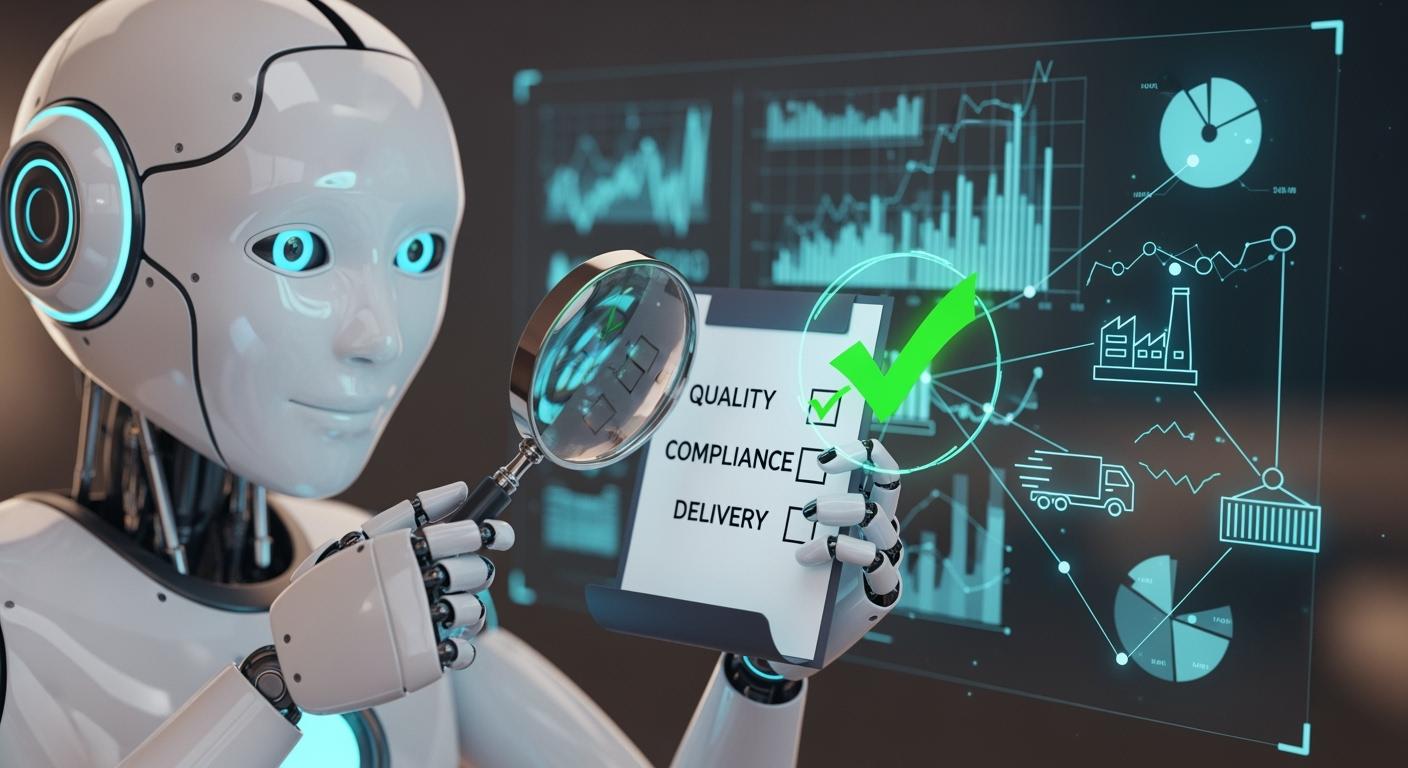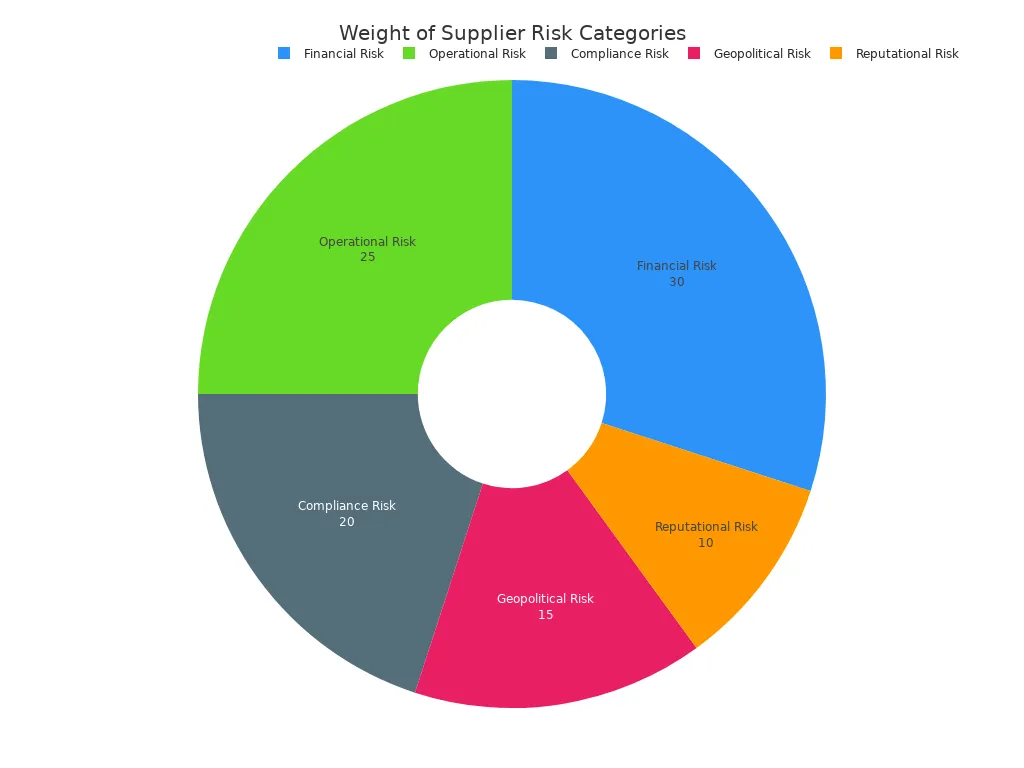
AI-driven analytics simplifies complex supplier risk management. AI helps procurement teams manage supplier risk effectively. It automates data collection for a complete risk assessment of each third-party supplier. This technology transforms the procurement process.
AI uncovers hidden supplier risk and enhances third-party risk management. The system provides clear automated risk scoring. This data-driven risk management approach eliminates manual work for procurement professionals. The AI scoring model identifies potential third-party supplier risk before it impacts the business.
Streamline supplier risk management

Effective supplier risk management is essential for a resilient supply chain. AI-driven analytics transforms this process from a manual burden into a strategic advantage. It automates complex workflows, enhances risk visibility, and strengthens security.
Automate data collection and integration
Procurement teams often struggle with manual data collection. This outdated approach is slow and prone to errors. AI automates this entire process. The system gathers data from many sources for a complete view of each supplier. These sources include:
- Financial reports and legal databases
- News articles and social media feeds
- ESG ratings and proprietary information
This automation of risk management workflows eliminates tedious manual work. It allows procurement professionals to focus on strategic decisions instead of data entry. The impact on efficiency is significant.
| Metric | Manual Process | Automated Process | Impact |
|---|---|---|---|
| Cost per Invoice | $9 per paper invoice | $3–6 per digital invoice | 50–75% cost savings |
| Staff Efficiency | Full-time follow-ups | 50% time saved | Lower labor expenses |
Enhance third-party risk management
Supplier risk is a critical piece of a broader third-party risk management (TPRM) strategy. Many organizations lack full visibility into their supply chains, which exposes them to significant risk. AI makes third-party risk management more manageable. It integrates supplier checks into comprehensive risk management programs.
AI-enabled workflows automate continuous monitoring and vendor risk assessments. This ensures that the organization's compliance and security standards are met across all vendors. By improving third-party risk management, businesses can proactively identify and mitigate procurement risks before they cause disruptions. This strengthens the overall vendor risk management framework.
Uncover hidden sub-tier supplier risk
A major challenge in supplier risk management is the lack of visibility beyond the direct (Tier 1) supplier. A risk in a supplier's supplier (Tier 2 or beyond) can disrupt the entire chain. Manually tracking these N-tier relationships is nearly impossible.
Did You Know? AI performs network mapping to discover these hidden sub-tier connections. It analyzes vast datasets to identify dependencies and potential vulnerabilities.
This capability helps uncover hidden risks that could otherwise go unnoticed. These risks include:
- Financial instability in a small sub-tier supplier
- Workforce or human rights issues
- Cybersecurity threats from a third-party vendor
AI provides the deep visibility needed for true supply chain security. This proactive monitoring of all vendors helps procurement teams prevent problems before they impact the business.
How ai-driven analytics enhances risk assessment

AI-driven analytics elevates risk assessment from a reactive task to a proactive strategy. It moves beyond simple data collection. The technology provides deep, predictive insights into supplier behavior. This allows procurement teams to understand and mitigate risk with greater precision and security.
Analyze data with continuous monitoring
Traditional supplier risk management often relies on periodic reviews. This approach creates dangerous blind spots between assessments. AI introduces continuous monitoring for real-time visibility. This ongoing monitoring transforms how organizations manage supplier relationships and security.
“An annual risk assessment is no longer sufficient in the modern business environment. To stay ahead of the curve, businesses can no longer rely on manual compliance processes. They must leverage more advanced tools to proactively monitor risks and ensure sustained growth.” - Julian Harris, CEO of RobobAI
AI systems automate data analysis from countless sources. This provides a live picture of every supplier. The benefits of this approach are clear:
- Enhanced Risk Visibility: Ongoing transparency into vendor performance and financial health provides real-time insights.
- Faster Threat Response: Automated alerts enable an immediate reaction to incidents like cybersecurity threats or financial instability.
- Improved Compliance: AI workflows automatically track vendor obligations against regulatory frameworks like GDPR and ISO standards.
- Operational Efficiency: The system reduces manual workloads, freeing risk management teams for strategic analysis.
This level of monitoring is possible because AI automates complex workflows. It ingests data and uses Natural Language Processing (NLP) to interpret regulatory texts and news articles. The system flags specific events that signal a potential risk, such as declining sentiment on social media, unusual payment requests, or ESG violations. This constant vigilance is a cornerstone of modern third-party risk management.
Identify patterns with machine learning
AI uses machine learning (ML) to identify complex patterns that are invisible to human analysts. ML algorithms analyze vast historical and real-time datasets to learn what normal supplier behavior looks like. This allows the system to spot subtle irregularities that could indicate a larger risk. For example, Unilever used an AI system to analyze over 50 risk indicators, reducing fraudulent transactions by 35%.
Machine learning models can detect a wide range of risk patterns from large supplier datasets. These patterns include:
- Supplier reliability and stability based on historical performance.
- Future demand spikes or drops by examining market trends.
- Potential bottlenecks in transportation networks.
- Emerging geopolitical threats from news and social media analysis.
These AI models define a normal operational range for key metrics. They then apply advanced algorithms to surface irregularities. The system can identify invoice manipulation, conflicts of interest, or even collusion between employees and a supplier. A global fast-food chain used AI to identify alternative suppliers, reducing network distance by 25% and saving millions. These intelligent workflows empower procurement teams to make data-driven decisions that strengthen supply chain security.
Predict future supplier risk proactively
The most powerful feature of AI is its ability to predict future events. Predictive analytics uses historical data and machine learning models to forecast potential supplier risk before it materializes. This capability allows a business to move from reacting to disruptions to preventing them. The AI system analyzes critical data points to make these predictions. Key data includes:
- Delivery timelines and quality audit results
- Financial reports and credit ratings
- Market conditions and geopolitical events
- Sustainability reports and public records
This predictive risk modeling helps organizations anticipate specific problems. For instance, AI can forecast a supplier bankruptcy 6-12 months in advance by analyzing financial ratios and payment patterns. It can also predict quality degradation by identifying small upticks in minor issues. This foresight enables procurement professionals to take proactive steps. They can optimize inventory, develop contingency plans with alternate vendors, and stress-test their supply chains. This proactive stance is essential for building resilient risk management programs and avoiding costly procurement risks. The system can generate predictive alerting for a specific supplier, giving the procurement team time to act. This advanced risk assessment transforms the entire supplier management process. The AI provides a clear scoring of each supplier, simplifying complex decisions for all third-party vendors.
Simplify decisions with clear outputs
AI-driven analytics transforms complex supplier data into clear, simple outputs. This technology empowers procurement teams to make faster, more informed decisions. It simplifies supplier risk management by presenting insights in an accessible format.
Generate actionable risk scores
AI systems process vast amounts of data to generate a single, actionable risk score for each supplier. This automated risk scoring simplifies a complex risk assessment. The scoring is often a product of risk probability and its potential impact. This gives procurement a clear number to work with. The final score considers multiple risk categories.

This quantification of risk helps procurement teams prioritize their efforts. They can focus on the highest-risk vendors for mitigation. This data-driven approach strengthens security and prevents procurement risks.
Automate compliance checks
Ensuring regulatory compliance across hundreds of vendors is a major challenge. AI automates these critical compliance workflows. The system uses Natural Language Processing to scan supplier contracts for non-compliant clauses. It also provides ongoing monitoring for changes in global standards like GDPR or ESG mandates.
AI-powered risk management workflows create a complete audit trail. This log tracks all communications and actions related to a third-party supplier. It makes preparing for audits much faster and improves overall security.
This automation ensures that every supplier meets the organization's standards for regulatory compliance. It is a key part of a strong third-party risk management strategy.
Use dashboards and predictive alerts
AI platforms present all this information in user-friendly dashboards. These tools provide a central view of all third-party risk data. Procurement teams can see supplier performance, compliance status, and risk scores at a glance. This continuous monitoring offers real-time security insights.
The most powerful feature is predictive alerting. Traditional systems only send alerts after a problem occurs. AI uses predictive analytics and predictive risk modeling to forecast issues before they happen. This predictive alerting system analyzes trends to identify subtle signs of future risk. It allows procurement teams to act proactively, preventing disruptions and protecting the supply chain. These intelligent workflows transform how organizations handle risk.
AI transforms supplier risk management. The technology automates complex workflows for any procurement team. AI provides predictive risk insights and clear scoring for each supplier. This proactive approach to risk enhances third-party risk management.
Adopting ai-driven analytics is crucial for every procurement team. It helps the procurement team build a secure supply chain by mitigating supplier risk. The AI identifies hidden third-party supplier risk and improves compliance. This focus on risk and compliance strengthens the entire procurement process for every third-party supplier. AI makes procurement workflows more efficient.
FAQ
How does AI improve procurement risk management?
AI automates data analysis for procurement teams. It identifies supplier risk patterns. This proactive approach helps manage risk effectively. The system reduces manual work for procurement professionals, lowering overall risk.
What types of supplier risk can AI detect?
AI systems detect a wide range of risk factors. These include financial risk, operational risk, and compliance risk. The technology also uncovers reputational risk and geopolitical risk. This comprehensive risk assessment protects the business.
Can AI help with procurement compliance?
Yes, AI automates compliance checks. It scans contracts and monitors regulations. This ensures all suppliers meet standards. The system creates an audit trail, simplifying compliance management and reducing compliance risk for the procurement department.
Is this technology difficult for a procurement team to use?
No, these platforms are user-friendly. They present complex risk data in simple dashboards and scores. This design helps procurement teams make fast, data-driven decisions. The system simplifies the entire risk management process.
See Also
Revolutionary EDI Tracking Enhances Supply Chain Transparency for Modern Logistics
Leveraging Data Analytics for Optimal Product Selection and Business Growth
WarpDriven ERP: The Intelligent Choice for Advanced Supply Chain Operations
Achieving Rapid, Eco-Friendly Supply Chain Success Through Lean Logistics
Three Key Strategies: Lean Logistics for Sustainable Supply Chain Excellence